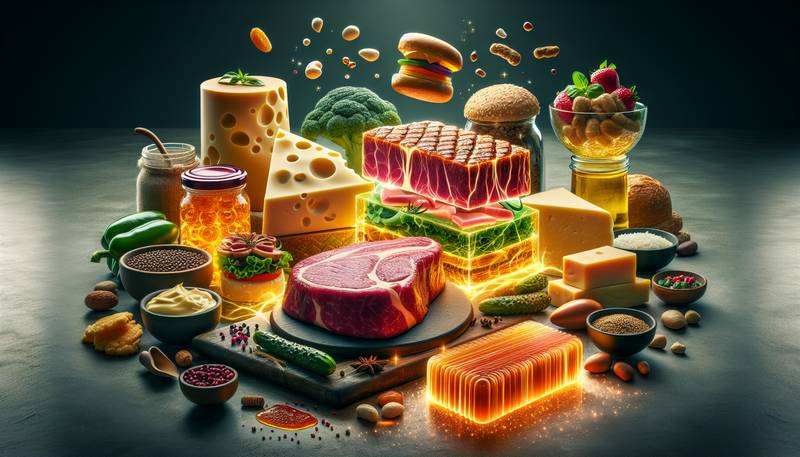Improving Texture in Plant-Based Foods: Role of Hydrocolloids

A Slippery Slope: The World of HydrocolloidsIt is a truth universally acknowledged that a plant-based food product in possession of a good texture must be in want of hydrocolloids. Well, perhaps not universally, but anyone who has endured the rubbery texture of many a poorly-made vegan cheese can attest to the importance of these curious substances. Hydrocolloids, you see, are the unsung heroes of the food world, the invisible force that holds your jellies together, your sauces thick, and your plant-based steak delightfully chewy.But what, you might ask with a furrowed brow and a faintly panicked expression, is a hydrocolloid? Fear not, dear gastronome, for we shall delve into the mysterious world of these culinary polymers, understanding their role in improving the texture of plant-based foods, and perhaps even emerging with a newfound appreciation for the humble thickener.Hydrocolloids: A Sticky IntroductionAt its core, a hydrocolloid is a substance that forms a gel when combined with water. These hydrophilic (water-loving) molecules have developed a reputation for being the life of the molecular party, clustering together in the presence of water, forming a network of delightfully flexible links that give rise to the gels, thickened liquids, and elastic solids we encounter in foods of varying textures.There is a veritable smorgasbord of hydrocolloids available for the intrepid food scientist, from natural gums like xanthan, guar, and gellan, to the proteins of the emulsification world, such as gelatin (though that one is decidedly not plant-based). However, each hydrocolloid has its distinct quirks and characteristics, and choosing the appropriate one for a specific application can be a journey akin to wandering through a maze filled with molecular partygoers who just can't decide which room to settle in.The Texture Tango: Hydrocolloids and Plant-Based FoodsIn plant-based foods, hydrocolloids are often called upon to fill the role of the gelatinous animal proteins that give many traditional foods their characteristic textures. From the sponginess of a marshmallow to the chewy bite of a gummy bear, these slippery characters must step up to the plate and emulate their animal-based counterparts with aplomb.But the task is not an easy one, as each hydrocolloid has its own unique quirks, strengths, and weaknesses. The key to success, then, is to partner the correct hydrocolloid with the desired texture and the specific plant-based ingredients being used, in a sort of culinary matchmaking process.A Guide to Hydrocolloid Harmony: Practical Tips for Texture TriumphsHaving established the vital role hydrocolloids play in the world of plant-based food texture, it is now our duty to provide some practical tips for those intrepid souls who wish to embark on the journey of hydrocolloid matchmaking. So, without further ado, here are a handful of guidelines to help you on your way:1. Know Your Hydrocolloid's PersonalityAs mentioned earlier, each hydrocolloid has its own unique characteristics, and getting to know them is the first step in ensuring a successful texture tango. For example, xanthan gum is a highly versatile gum that can create thick, stable gels at a wide range of pH levels, while guar gum excels at generating thick, creamy textures, but is more sensitive to pH variations. So, don't be afraid to do a little research on your potential hydrocolloid partner before you hit the dance floor.2. Test Your Hydrocolloids with Different IngredientsPlant-based ingredients can have a wide range of behaviors when combined with hydrocolloids, and it is crucial to test your chosen hydrocolloid with the specific ingredients you plan to use in your final product. Some hydrocolloids may play nicely with certain plant-based proteins but completely lose their gel-forming mojo when confronted with a different protein source. It's a bit like trying to dance the tango with a partner who suddenly decides to break into a waltz halfway through the song – the result is likely to be less than harmonious.3. Get Your Ratios RightOne of the critical factors in achieving the perfect hydrocolloid-texture partnership is getting the proportions of your hydrocolloid just right. Too little, and your plant-based creation may be as limp and lifeless as a deflated balloon; too much, and you risk venturing into rubbery, unpalatable territory. The ideal ratio will depend on the hydrocolloid and the specific application, so experimentation is key. Remember, Rome wasn't built in a day, nor was the perfect vegan gummy bear.4. Keep an Eye on Your Processing ParametersTemperature, pH, and mixing speed can all have a significant impact on the behavior of your hydrocolloids and the resulting texture of your plant-based products. Don't be afraid to experiment with different processing parameters, and always keep detailed records of your trials to ensure that you can replicate your successes and learn from your failures.Armed with this newfound knowledge of hydrocolloids and their role in plant-based food texture, you are now ready to venture forth into the culinary world, confident in your ability to navigate the slippery slope of hydrocolloid matchmaking. May your plant-based creations be texturally triumphant and your hydrocolloid partners forever harmonious!
|
|







